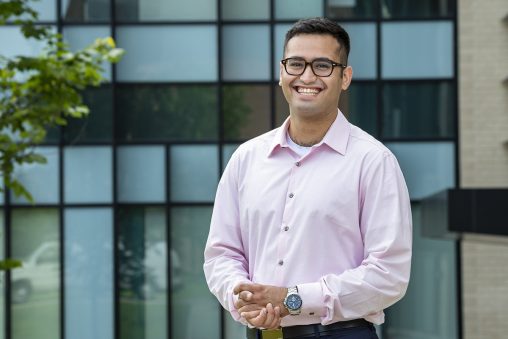
Ibrahim Abdulhalim, a student in the combined B.S./M.S. Biomedical Engineering Program, participated in the Summer Undergraduate Research Fellowship Program at the Mayo Clinic. (Photo by Erin Pence)
Finding the right summer research internship was a goal for Wright State University biomedical engineering student Ibrahim Abdulhalim. Getting to conduct research over the summer break would help him to stay on a path to eventually earn a Ph.D. in biomedical engineering.
“The field of biomedical engineering is always changing, and innovations are always being made,” he said. “To become a pioneer in the field I would have to conduct research and innovate to contribute to its growth.”
Abdulhalim found a great internship opportunity in the Summer Undergraduate Research Fellowship Program at the Mayo Clinic, in Rochester, Minnesota. Sponsored by the Mayo Clinic Graduate School of Biomedical Sciences, the fellowship program attracts outstanding undergraduate students like Abdulhalim who are interested in a career in biomedical research as a Ph.D. or M.D./Ph.D.
Abdulhalim interned in the Mayo Clinic’s radiology department, where he was able to participate in laboratory research, develop new technical skills, attend seminars and connect with numerous researchers in the fields of medical imaging, physics, prosthetics and orthotics.
He is a student in the combined B.S./M.S. Biomedical Engineering Program offered by the Wright State College of Engineering and Computer Science. He is pursuing a bachelor’s degree in biomedical engineering and a master’s degree in neuroengineering.
His focus is exploring a connection between the body’s kinematics and the human nervous system.
Abdulhalim’s long-term goal is to pursue a Ph.D. in the field of biomedical engineering. His passion lies in conducting research in the biomedical engineering and neuroscience fields and sharing his findings with the world through teaching.
“As my interest grew with time, I started falling in love with the beautiful and dynamic relationship between the nervous system and the body’s kinematics,” he said.
During his nine-week internship at the Mayo Clinic, Abdulhalim was introduced to new methods of image analysis through the coding languages Matlab and python and other digital formats used to view medical images. In addition, he learned about the application of artificial intelligence in CT imaging and its importance to the field of biomedical engineering.
He said he was well-prepared for this work thanks to his courses in the Department of Biomedical, Industrial and Human Factors Engineering.
“The knowledge I obtained from the medical imaging course at Wright State helped me understand the different CT imaging techniques,” he said.
During his internship, he also attended weekly seminars and talks on biomedical engineering and other fields, participated in team meetings and presented his work to his team.
While his internship was not in his desired field, Abdulhalim still benefited from the internship at the Mayo Clinic. The experience taught him not to turn down great opportunities.
“If you receive an opportunity in your field but not in your area of interest, take it,” he said. “The field of biomedical engineering is dynamic, therefore, what you learn in one focus area you might find handy in another.”
As he enters his senior year at Wright State, Abdulhalim is working on his thesis on haptics and prosthetics with Caroline Cao, Ph.D., professor of biomedical, industrial and human factors engineering; mechanical and materials engineering; and surgery. He is also a member of Tau Beta Pi, the National Engineering Society.
Abdulhalim enrolled at Wright State because the Department of Biomedical, Industrial and Human Factors Engineering offers smaller classes, providing a strong connection between students and faculty members.
He also likes the Wright State campus. “The campus is the perfect size, where students are able to walk from class to class with no worry of taking any transportation,” he said.

 Milling around
Milling around  Wright State recognizes Nursing Professor Kim Ringo for advancing international student success
Wright State recognizes Nursing Professor Kim Ringo for advancing international student success  Wright State honors graduating students for distinguished doctoral dissertations
Wright State honors graduating students for distinguished doctoral dissertations  Top 10 Newsroom videos of 2025
Top 10 Newsroom videos of 2025  Museum-quality replica of historic Hawthorn Hill donated to Wright State
Museum-quality replica of historic Hawthorn Hill donated to Wright State 